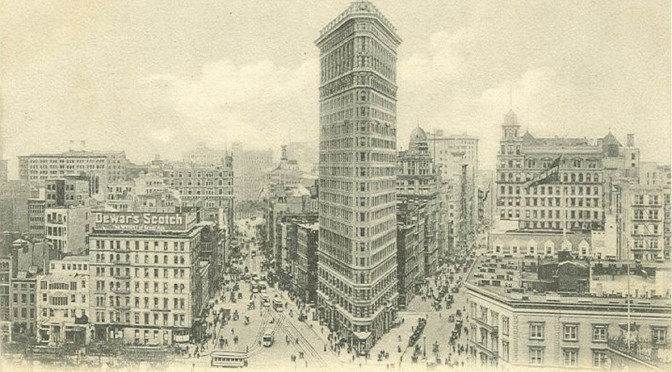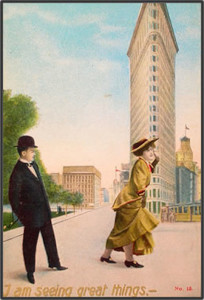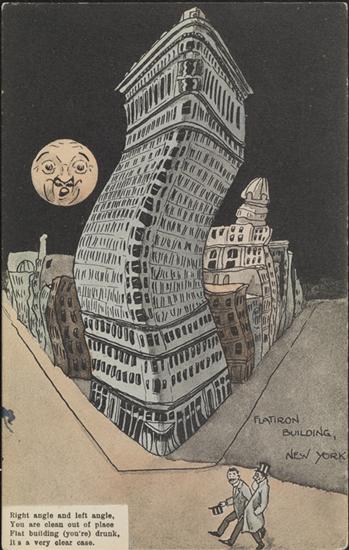PODCAST For our 8th anniversary episode, we’re revisiting one of New York City’s great treasures and a true architectural oddity — the Flatiron Building.
When they built this structure at the corner of Madison Square Park (and completed in 1902), did they realize it would be an architectural icon AND one of the most photographed buildings in New York City?
The George A. Fuller Company, one of the most powerful construction firms in Chicago, decided to locate their new New York office building in a flashy place — a neighborhood with no skyscrapers, on a plot of land that was thin and triangular in shape. They brought in Daniel Burnham, one of America’s greatest architects, to create a one-of-a-kind, three-sided marvel, presenting a romantic silhouette and a myriad of optical illusions.
The Flatiron Building was also known for the turbulent winds which sometimes blew out its windows and tossed up the skirts of women strolling to Ladies Mile. It’s a subject of great art and a symbol of the glamorous side of Manhattan.
In this show, we bring you all sides of this structure’s incredible story.
Below: A cleaned up look at the Flatiron Building, courtesy Shorpy. Click here for a look at the details!
The Bowery Boys: New York City History podcast is brought to you …. by you!
Starting this month, we are doubling our number of episodes per month. Now you’ll hear a new Bowery Boys podcast every two weeks. We’re also looking to improve the show in other ways and expand in other ways as well — through publishing, social media, live events and other forms of media. But we can only do this with your help!
We are now a member of Patreon, a patronage platform where you can support your favorite content creators for as little as a $1 a month.
Please visit our page on Patreon and watch a short video of us recording the show and talking about our expansion plans. If you’d like to help out, there are five different pledge levels (and with clever names too — Mannahatta, New Amsterdam, Five Points, Gilded Age, Jazz Age and Empire State). Check them out and consider being a sponsor.
We greatly appreciate our listeners and readers and thank you for joining us on this journey so far. And the best is yet to come!
A dramatic illustration of 23rd Street and Fifth Avenue, where the Flatiron Building would soon stand. From here you can see the taller Cumberland building which would be used for billboards.
The structures that pre-dated the Flatiron Building, pictured here in 1897.
The smaller buildings have already been cleared away for the construction of the Fuller/Flatiron Building, but the taller building remains to some promotion of Heinz products.
Construction of the Flatiron, picture from late 1901 or early 1902.
From every angle, the Flatiron takes on a new shape…..
…inspiring artists like Edward Steichen to frame the building in romantic and even mysterious ways (such as his iconic shot from 1904)
A view, similar to the classic one above, of the Flatiron after a snowstorm in 1905
The Flatiron has inspired thousands of photo-mechanical post cards back in the day, highlighting its alluring shape-shifting form upon the changing New  York skyline.
The cigar store in the narrow ‘cowcatcher’ served as a recruitment office during World War I, topped with military weaponry.
Another postcard focused on the Flatiron’s particularly windy properties!
American Mutoscope and Biography Co. filmed this humorous look at ladies in the wind on October 26, 1903:
A Max Ettlinger illustration from 1915 — Flatiron, you’re drunk!
A July 4th parade, passing up Fifth Avenue.
The Flatiron in 1935, from an angle that makes it appear almost two dimensional.
The Flatiron — still a magnet for budding photographers everywhere! Here a couple modern images from photographers Jeffrey Zeldman, Thomas Hawk, Giandomenico Ricci, Anurag Yagnik, and eric molina.
CORRECTION: A small correction to this week’s show. The beautiful Madison Square Garden tower — with the nude Diana statue — is actually in a Spanish style, not an Italian style.


























4 replies on “Flatiron Building: A Three-Sided Story”
In the 1980’s I lived at the Seville Hotel on 29th and Madison and attended NYU, so I walked by the Flatiron every day. At that time there was a seven-foot statue of a snail that stood opposite 23rd street from the Flatiron. It was there for about 2 years then was replaced by some giant cubes. I’ve often wondered about that snail — why was it there? Who made it? What did it mean?
Greg mentioned that the Flatiron used to house the American Ping Pong Association. I thought he might go on to mention that the block below the Flatiron — on Broadway between 21st and 22nd — used to be the center of all the novelty manufacturers, you know, joy buzzers, whoopee cushions, fake fly in ice cubes, etc. The Toy Center used to be on 23rd and 5th (now Eataly and a Lego Store) where until very recently they held the annual Toy Convention (which has moved to the Javits Center).
Didn’t know about the Hydraulic Elevators! Those sound like fun! Especially on a hot day like today. How about a water slide from the top floor to the street!
Great post on the Flatiron !
You might be interested in this:
http://galessandrini.blogspot.fr/2012/09/flatiron-fascination.html
Kindest regards,
GA.
About 2 months ago, I came accross your podcast and since then every morning on my way to work in Toronto, I listen to a different one. I usually only get 70 percent through one before arriving to work, and the next morning I’ll finish it. I’ve got into the routine of going to the website when I start my shift to look at the post on the website. I usually then wil go to Google streetview and look around the area that you guys detailed in that podcast. Its very interesting and love having these history lessons, so thank you! As I’m sure you have a difficult time thinking of the next topic to cover I think an SNL podcast would be interesting. Also an episode dedicated to Mad Men! It just had its (dissapointing) series finale and after all it was a New York based show. Lots of landmarks to cover during a Mad Men specific one, including PJ Clarks, which until the other day I did not know was a real place. Anyway thanks guys! Continue on!
Thanks for the pictures. Just one small comments. That last black & white photo is not from 1935 – as can be told from the 60’s or 70’s style cars in the foreground and the double-guy wired traffic light posts which only started to appear in the 1950’s.